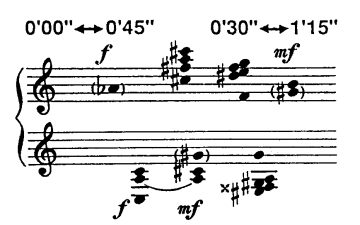Frances plays the shakuhachi (Japanese bamboo flute). We thought that it would be fun to play something together, but there isn’t a whole lot of literature for shakuhachi and piano. But we thought that we could adapt John Cage’s Two, originally for flute and piano. I’ve started working on it, and thought I’d take a few posts to describe the process of learning the piano part.
Composed in 1987, Two was the first “number piece” that Cage wrote, and the score will look familiar to anyone who’s seen any of those pieces. It consists of ten bits of music with flexible timing indicated. Here’s the first segment:
Cage provides instructions, first about the timing:
Each part has ten time brackets, nine [of] which are flexible with respect to beginning and ending, and one, the eighth, which is fixed. No sound is to be repeated within a bracket.
So in the example above, the time notations indicate that I can start playing that music at any time in the first 45 seconds of the piece, and I must finish it sometime between 30 seconds and 1:15 into the piece. So I could start at 0:30, play really quickly, and finish at 0:45. Or I could stretch it out, starting at 0:03 and finishing at 1:12. But if I’m taking my time, it will be by playing the sequence of chords more slowly, since I can’t repeat anything.
The piano part has some further, special instructions:
In the piano part each ictus in a single staff is to be played in the order given, but can be played in any relation to the sounds in the other staff. Some notes are held from one ictus to the next. A tone in parentheses is not to be played if it is already sounding. One hand may assist the other.
So in the example above, I have to play the four chords in the right hand in that order, and the three chords in the left in that order, but the relationship between the two hands is free: I don’t have to follow the layout shown in the score. I could play all four chords in the right hand followed by the three in the left. I could play the first three chords in each hand simultaneously, followed by the last one in the right hand. And so on: there are lots of possibilities.
Cage doesn’t say a thing about the durations of each individual chord, so I have to assume that this is up to me, too. Given the flexibility in overall timing with the brackets, I have to be able to spread these chords out over longer periods of time (up to 1:15 total duration). This means that there can be a lot of space between the chords, either sustained resonances (if I hold them for long durations) or silences (if I don’t). In later pieces in this series, it was common for Cage to indicate that durations should be short when the dynamic is louder, and long with the dynamic is softer. I think that he made this instruction because, quite simply, he liked the way that sounded. This being the first of the series, he hadn’t discovered that yet, but I’m going to follow that rule here even though it isn’t explicitly stated. So when I play the example above, the forte chords will be very short, with silence around them, but the mezzo-forte ones will be more sustained.
The rest of the instructions are pretty clear. Tied notes are played exactly the way they appear: you hold them between chords. So that first chord in the left hand will be loud and short, except for the A-natural, which I’ll hold until I’m ready to play the next chord. And the parenthetical notes are just a convenience for the performer: they are a reminder that you don’t have to play those notes if they’re already sounding in the other hand. So if the right hand is still playing the opening A-flat when I get to that second chord in the left hand, I can’t play the G-sharp — the parenthesis reminds me of that.
That’s all the instructions Cage gives. He doesn’t mention dynamics, but they are clearly notated in the usual manner (my assumption is that if a chord has no dynamic marking, the previous one applies, as you would expect). And it almost goes without saying that, as a Cage piece, the flute part is totally independent of the piano part.
So how do I go about learning a piece like this? There are lots of options here about overall timing and especially the local chord-to-chord timing, both in terms of the rhythm of each hand and the relations between them. How do I decide what to do? I’ve been working on it, and I’ll describe more in my next post.


Thanks a lot. Very helpfull.